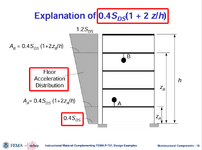Navigation
Install the app
How to install the app on iOS
Follow along with the video below to see how to install our site as a web app on your home screen.
Note: This feature may not be available in some browsers.
More options
Style variation
-
Congratulations MintJulep on being selected by the Eng-Tips community for having the most helpful posts in the forums last week. Way to Go!
You are using an out of date browser. It may not display this or other websites correctly.
You should upgrade or use an alternative browser.
You should upgrade or use an alternative browser.
ASCE 7-16 Equation 13.3-1
- Thread starter LS_SMS
- Start date
HTURKAK
Structural
- Jul 22, 2017
- 3,377
No..Can I divide F_p by W_p to get the acceleration on the left side? And if so, would the units for acceleration then be g's?
Pls look to the following doc. and provide more info. for your specific case to get better responds.
FEMA nonstructural components
Attachments
- Thread starter
- #3
I'm doing FEA on a small pressure vessel. It's a nonstructural component listed in Table 13.6-1. In the FEA, I would like to fix the mounting lugs and apply the seismic acceleration to the vessel to get its results. As is, I don't see how to apply the F_p force from Eqn. 13.3-1. It's unclear where that force would be applied to the vessel.
Slide 16 of your PDF insinuates that 0.4*S_DS*(1 + 2*z/h) is the acceleration. Could I shift the other terms to the opposite side to get the acceleration this way?

Slide 16 of your PDF insinuates that 0.4*S_DS*(1 + 2*z/h) is the acceleration. Could I shift the other terms to the opposite side to get the acceleration this way?

HTURKAK
Structural
- Jul 22, 2017
- 3,377
-Fp force would be applied to center of gravity.I don't see how to apply the F_p force from Eqn. 13.3-1. It's unclear where that force would be applied to the vessel.
-As you have noticed , the expression ( 0.4SDS(1 + 2 z/h) ) is floor acceleration coeff. and varies btw 1.2 Sds ( if the vessel at the top storey )and 0.4Sds. ( if the vessel supported on ground ).
I will suggest you ;
- Calculate the Fp with using expression (13.3-1) and check with the expressions (13.3-2) and (13.3-3) then apply to the COG of the component.
- Use overstrength factor Ω0, in Table 13 for anchorage of component to concrete.
- The units of Fp is Force and the Wp is weight . Be careful for the consistent units if you want to use acceleration .
- Thread starter
- #5
Thank you for the additional feedback. I studied your PDF as well as Chapters 11 and 13 in ASCE 7-16.
From Chapter 11, Figure 11.4-1 and Eqn. 11.4-5 tells how to calculate acceleration below T_o. So when T = 0, ground acceleration is 0.4*S_DS. Units are in g's as shown in Figure 11.4-1. Taking a look at Eqn. 13.3-1, as you move vertically through the building, (1 + 2*z/h) linearly increases the acceleration. So at its max, (1 + 2*z/h) must equal 3, which means the max acceleration at the roof is 1.2*S_DS. This tells me the acceleration for the building ranges between 0.4*S_DS and 1.2*S_DS (this is confirmed in ASCE 7-16 §C13.3 also). By deduction, the other coefficients in Eqn. 13.3-1, except for W_p being the object's weight, are modifiers on the acceleration based on component importance, building height, etc.
With that said, I believe my original understanding in my first post is correct, but do remain open to counter statements.
From Chapter 11, Figure 11.4-1 and Eqn. 11.4-5 tells how to calculate acceleration below T_o. So when T = 0, ground acceleration is 0.4*S_DS. Units are in g's as shown in Figure 11.4-1. Taking a look at Eqn. 13.3-1, as you move vertically through the building, (1 + 2*z/h) linearly increases the acceleration. So at its max, (1 + 2*z/h) must equal 3, which means the max acceleration at the roof is 1.2*S_DS. This tells me the acceleration for the building ranges between 0.4*S_DS and 1.2*S_DS (this is confirmed in ASCE 7-16 §C13.3 also). By deduction, the other coefficients in Eqn. 13.3-1, except for W_p being the object's weight, are modifiers on the acceleration based on component importance, building height, etc.
With that said, I believe my original understanding in my first post is correct, but do remain open to counter statements.
BulbTheBuilder
Structural
There is a possibility that you need to use chapter 15 not 13. You have the right idea though -review the clauses below.I'm doing FEA on a small pressure vessel.
"13.1.1 Scope. This chapter establishes minimum design criteria for nonstructural components that are permanently attached to structures and for their supports and attachments. Where the weight of a nonstructural component is greater than or equal to 25% of the effective seismic weight, W, of the structure as defined in Section 12.7.2, the component shall be classified as a nonbuilding structure and shall be designed in accordance with Section 15.3.2."
"13.1.6 Application of Nonstructural Component Requirements to Nonbuilding Structures. Nonbuilding structures (including storage racks and tanks) that are supported by other structures shall be designed in accordance with Chapter 15. Where Section 15.3 requires that seismic forces be determined in accordance with Chapter 13 and values for Rp are not provided in Table 13.5-1 or 13.6-1, Rp shall be taken as equal to the value of R listed in Chapter 15. The value of ap shall be determined in accordance with footnote a of Table 13.5-1 or 13.6-1"
Similar threads
- Replies
- 2
- Views
- 8K
- Replies
- 2
- Views
- 6K
- Question
- Replies
- 11
- Views
- 11K
- Question
- Replies
- 1
- Views
- 4K
- Question
- Replies
- 11
- Views
- 11K
